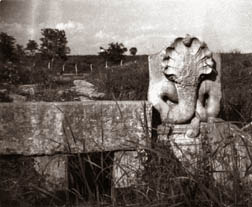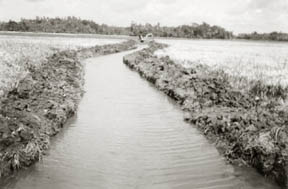|
observer |
|
|
|
|
|
OTHER LINKS |

|

|

|
|
Ancient irrigation works: Sri Lanka's hydraulic heritageSri Lanka may not be a pioneer in modern engineering, but be assured that a millennium or two ago the islanders were the wonder of the age with their stupendous irrigation works. Although many of the tanks (reservoirs), sluices and canals fell into disuse during later eras, a large number have been restored so that Sri Lanka's hydraulic heritage remains a living one.
Two important factors were responsible for Sri Lanka's renowned ancient prosperity: maritime trade and agricultural success. Maritime trade was facilitated by the island's central position in the Indian Ocean astride one of the most important trade routes of the ancient world, and it's own, much sought after, natural resources of pearls, spices, gems and elephants. There is ample material evidence to show that Sri Lanka benefited by trading with several dynamic Indian principalities. The island grew in importance as it offered safe anchorage for ships carrying goods between the ancient cultural hubs of imperial Rome and dynastic China. Agricultural success, however, was a direct result of the development, spread and maintenance of a remarkable irrigation network without a parallel in the ancient world. Of all the sciences that Sri Lankans mastered in the past, ancient irrigation works exhibit extraordinary expertise and innovation in their construction. This fact makes the remains of Sri Lanka's ancient irrigation works a part of the world's technological and cultural heritage. Early sluices incorporating the valve pit or biso kotuwa show an unparalleled level of engineering sophistication for their time. The sluices facilitated the timely release and control of water issuing from major storage reservoirs, that we in Sri Lanka call tanks. It is evident that as far back as 2,000 years ago, the extensive irrigation network that we see today was already being put into place. These pioneering efforts were crucial to an agricultural society that based its early prosperity on, and had for its staple, irrigated rice. Until that time such a crop was subject to the vagaries of monsoon rains. Subsequently the island became known as the "granary of the East," and the ancient Chinese referred to it as the "land without sorrow," both names due to the benefits accrued from the outstanding success of irrigated agriculture.
To understand the rise and fall of ancient irrigation is to understand the rise and fall of Sri Lankan civilisation. The most telling evidence comes from the rapid collapse of dry zone civilisation, preceded by the systemic collapse of ancient irrigation after flourishing in the north-central and southeastern dry zone for over one thousand years. Left behind in the wake of this sudden collapse were several weak, feuding principalities, which seem to have lost their links to the ancient knowledge. The most visible remains of ancient irrigation works are the massive earthen embankments of large tanks and canals. Many of these structures, locally known as bunds, have been renovated. Many of them support modern roads and are taken so much for granted that most people are unaware of their ancient origins. Other associated irrigation structures incorporated into bunds are sluices and cut-stone or natural rock spills. Many larger tanks still have ancient wave-breaker blocks paving their upstream face, mixed in with more modern blocks from renovations. Then, there are the canals leading from tank sluices and others that connected large and small tanks or tapped rivers to feed the network criss-crossing the countryside. Un-renovated canals are not easily identifiable, as some have become natural watercourses, while others have all but disappeared due to an infill of sand and debris over the centuries. Among the most impressive ancient irrigation structures are anicuts or amunas. These are massive cut-stone weirs or barrage dams built across perennial or seasonal rivers and streams. By the Polonnaruwa period they were used across the island's largest rivers. Constructed of dressed blocks of granite, up to half-a-ton or more, several courses high and wide, they were articulated together with the use of lipping, and mortise and tennon joints, fashioned out of the blocks themselves. The ends, anchored to the river banks, show the use of fired bricks and, at least in later anicuts, the use of a waterproof lime and pebble concrete. These anicuts formed an impermeable wall across the river, thereby artificially raising river levels in order to feed one or more canals, which in turn fed giant tanks. The study of ancient irrigation in the island reveals that the architects of the system were well-versed in rainfall patterns, landform, soil properties, construction materials - as well as their limitations and application - and above all had an amazing grasp of hydro-dynamics. From our standpoint in a technologically advanced computer age, we may be prone to devalue the achievements of ancient Sri Lankans. However, there is every indication that more than a millennia before the words scientific and engineer were coined, Sri Lankan irrigation involved engineers who probably underwent formal training in techniques that formed a corpus of codified knowledge requiring an understanding of the sciences. Not only the loss of ancient knowledge but also the loss of material hampers the proper understanding of how some of the ancient irrigation structures functioned. Canal head works, gates within the biso kotuwa, gates in anicuts: all these have left behind tantalising traces such as slots, holes and grooves carved into stone. Due to the perishable nature of the materials used (e.g. wood, iron and terra cotta) nothing remains of the mechanisms themselves. The archaeology of irrigation forms a large part of the archaeological heritage of the island of Sri Lanka. Two hundred and seventy eight major tanks and 25,000 minor tanks are known to exist in the island. Each of these tanks contained one or more sluices belonging to at least three distinct types referred to in literature. (The sluice incorporating the biso kotuwa is, in all probability, an early Sri Lankan invention.) Many of these larger tanks and anicuts and numerous small tanks have been renovated during 180 years of colonial and post-colonial irrigation activity, often obliterating the physical remains of ancient irrigation works. However, forested areas of the dry zone still harbour undisturbed irrigation works, albeit in a state of disrepair. Today, along with all other archaeological sites, these ancient structures are under constant threat from the destructive attention of mindless treasure hunters. The systematic study of these ancient remains is important to understand their proper function as well as the technology behind their construction. This in turn will shed more light on a past of which all Sri Lankans can justifiably be proud. SLT |










